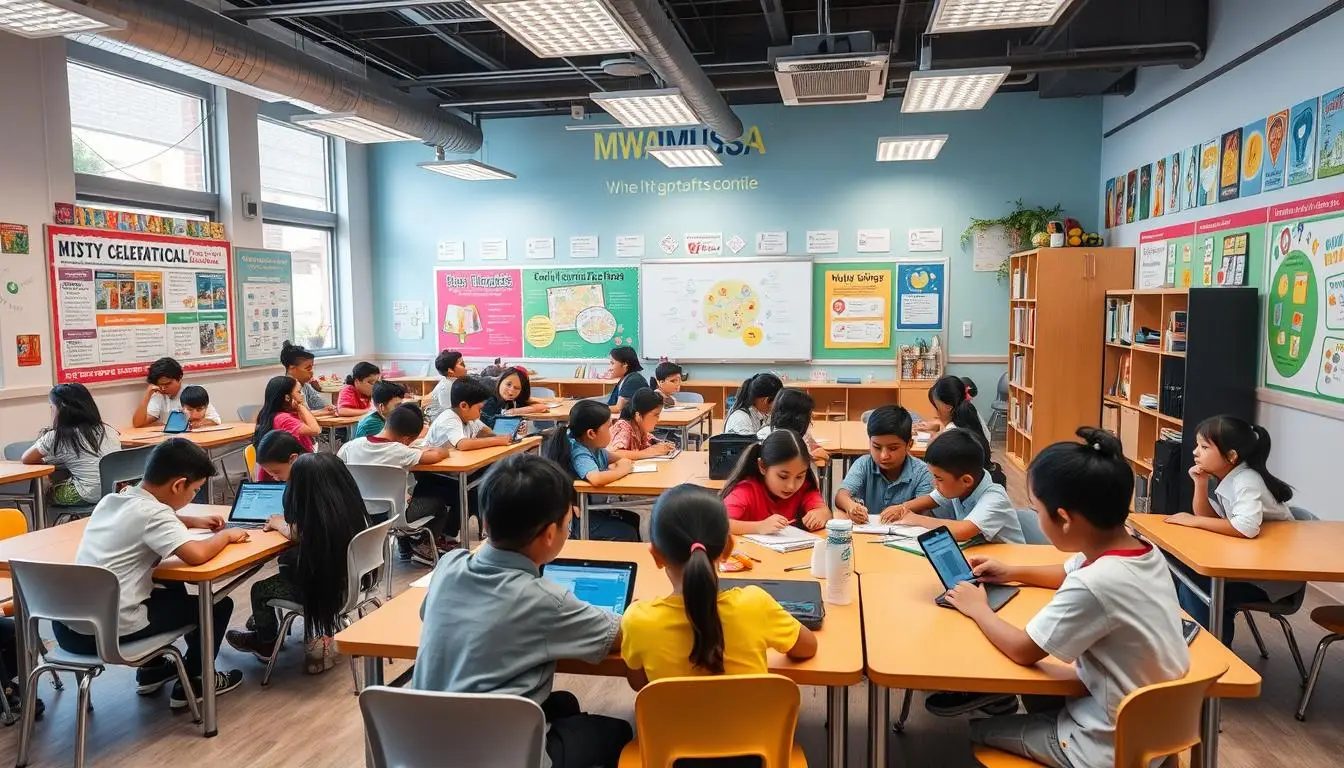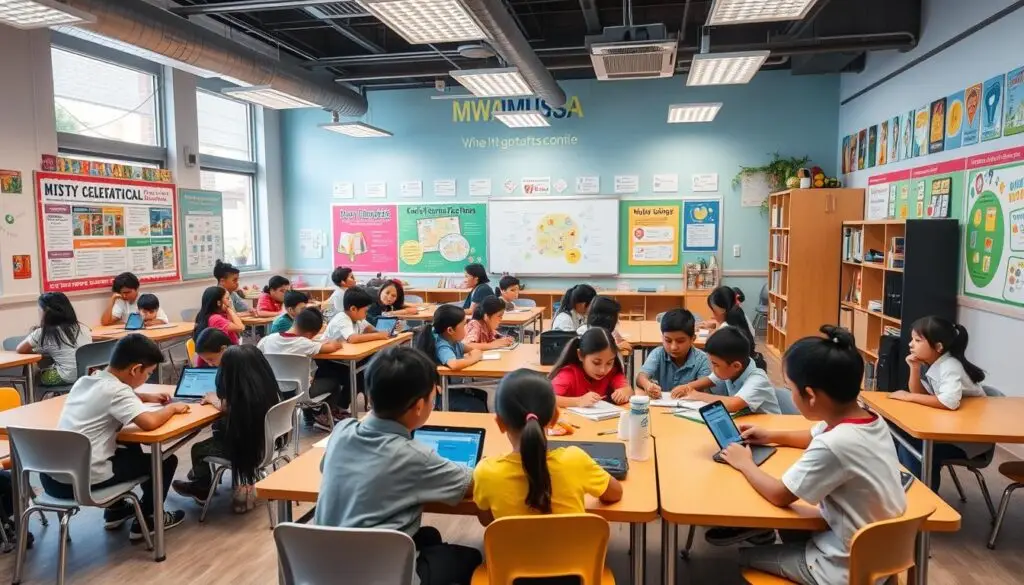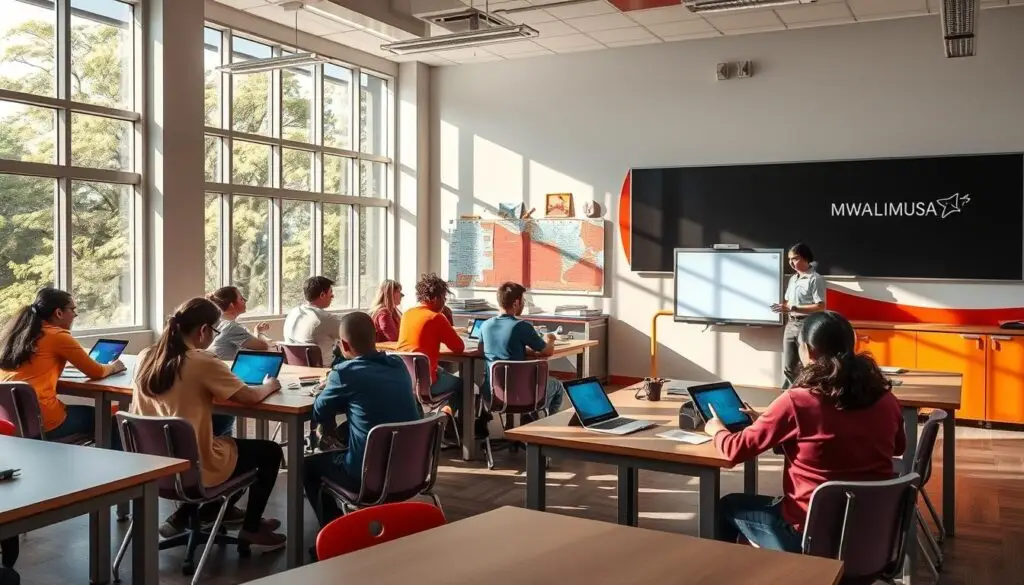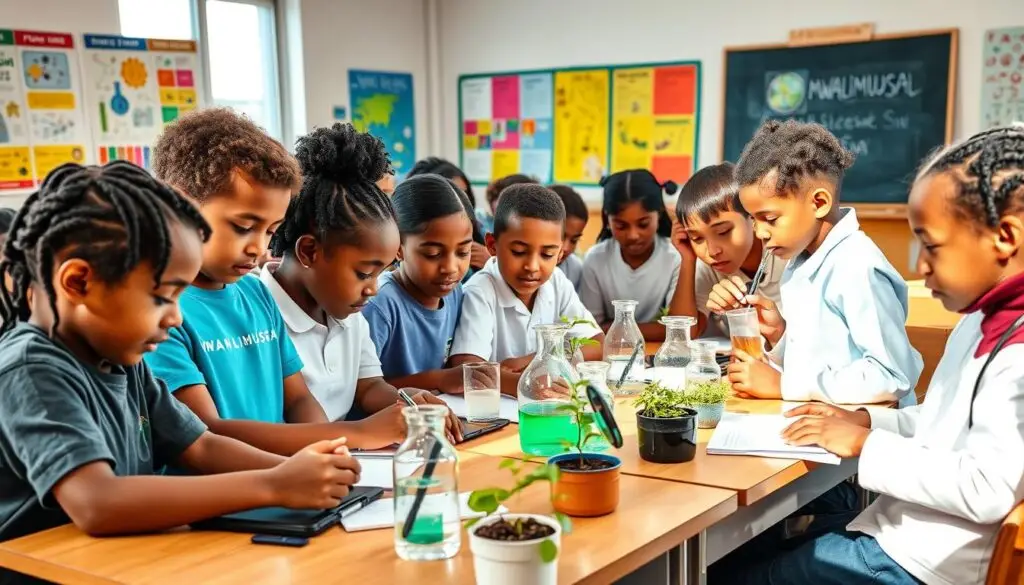Innovative Teaching Methods for the Modern Classroom

In today’s fast-changing education world, teachers in Kenya are using new teaching methods. They’re making the classroom more exciting with active learning, technology, and focusing on students. This article will look at ways like gamification, the flipped classroom, and working together in class. These methods aim to boost student interest, thinking skills, and success.

Key Takeaways
- Embrace active learning techniques to foster student engagement and collaboration
- Leverage technology-enhanced education to create interactive and immersive learning environments
- Adopt a student-centered approach to tailor instruction to individual needs and learning styles
- Incorporate gamification and the flipped classroom model to make learning more engaging and fun
- Implement differentiated instruction and inquiry-based teaching to nurture critical thinking skills
Embrace Active Learning Techniques
In today’s classrooms, the old lecture style is being replaced with active learning techniques. These methods focus on getting students involved and engaged. By using discussions and collaborative activities, students take a bigger part in learning. This makes them understand and remember course material better.
Student Engagement Through Discussions and Collaborative Activities
Getting students involved in discussions and group work is a great way to keep them interested and deepen their learning. When they talk and work together, they think more critically and feel more in charge of their learning.
- Encourage class discussions on important topics, letting students share their views and question each other’s thoughts.
- Set up group projects that need teamwork, using everyone’s different skills and experiences to tackle tough problems.
- Use peer-to-peer learning, where students teach and learn from each other, making important ideas stick.
Hands-on Experiments and Project-Based Learning
Hands-on experiments and project-based learning let students use what they know and improve their problem-solving skills. Doing real activities and projects, students get a deeper understanding and find more purpose in their learning.
| Active Learning Technique | Benefits |
|---|---|
| Hands-on Experiments | Helps students understand scientific concepts better, boosts critical thinking and problem-solving abilities. |
| Project-Based Learning | Makes students apply what they know to real problems, promotes teamwork and communication. |
By using these active learning techniques, teachers can make classrooms exciting and motivating. This encourages students to take an active role in their learning.
Leverage Technology-Enhanced Education
In today’s world, using digital tools in the classroom makes learning better. Tools like interactive whiteboards and educational software help students stay engaged. They make lessons more dynamic and fun.
Interactive Whiteboards and Educational Software
Interactive whiteboards change how teachers teach and talk to students. These boards let teachers use videos, animations, and more in their lessons. Students can touch the board to change what’s on it, making learning together more fun.
Educational software adds more to the classroom. It works on computers, tablets, or phones. It has exercises, virtual labs, and learning that’s made just for each student. This helps teachers reach students in different ways, making them understand better.
Virtual Reality and Augmented Reality in the Classroom
VR and AR are changing how students learn. VR takes them into three-dimensional worlds, making learning new things fun. AR adds digital info to the real world, making lessons more interactive.
These new tech tools let students get hands-on with what they’re learning. This helps them understand tough topics better. As VR and AR grow, so does the chance for new, exciting ways to learn.
Using technology in education makes learning exciting and personal. It helps teachers create lessons that grab students’ attention and lead to success.
Foster Student-Centered Approaches
In today’s classrooms, teaching methods focus on the student-centered approach. This means teachers look at what each student needs and how they learn best. By making learning personal, giving students a say in their education, and adjusting content for them, teachers help students take charge of their learning.
Students get more control over their learning with a student-centered approach. Teachers use methods like flexible pacing. This lets students pick from different activities and set their own goals. This way, students are more involved and motivated, which helps them learn better.
A student-centered classroom also values what each student brings to the table. By letting students share their thoughts and make choices, teachers make learning more inclusive. Students feel they can contribute, ask questions, and take part in their education.
| Student-Centered Approaches | Benefits |
|---|---|
| Personalized Learning | Tailors instruction to individual needs and preferences |
| Student Voice and Choice | Promotes engagement, ownership, and self-directed learning |
| Flexible Pacing | Allows students to learn at their own pace |
By using student-centered approaches, teachers can make learning exciting and empowering. Students become more involved in their education and grow academically.
Innovative Teaching Methods for the Modern Classroom
In Kenya, new teaching methods are changing how students learn. They focus on student engagement and better learning outcomes. These new ways are getting students ready for the 21st century challenges. They use research and the latest technologies to make learning fun and fit for all students.
Tools like interactive whiteboards and virtual reality are making classrooms more exciting. These tools grab students’ attention and help them understand better. Teachers use technology to make learning fun and interactive, encouraging students to think deeply and work together.
Student-centered learning is key in Kenya’s new teaching methods. It focuses on what each student needs and how they learn best. This way, students take charge of their learning, getting feedback and learning at their own pace. It helps them feel in control of their school work.
“Innovative teaching methods in Kenya are not just about delivering content; they’re about creating dynamic, immersive learning experiences that inspire and empower students to reach their full potential.”
These new teaching methods are all about making students more engaged and achieving better results. They teach teamwork, critical thinking, and solving problems. As Kenya keeps adopting these new ways, the future of education looks very promising.
Gamification: Making Learning Fun
Make learning exciting in your classroom with gamification. Add game elements to tap into your students’ love for play and challenge. This makes learning fun and engaging.
Game-Based Learning and Classroom Competitions
Bring game-based learning into your lessons for excitement and competition. Start classroom competitions that boost teamwork, problem-solving, and critical thinking. These activities make learning a fun adventure and help students develop important skills.
Rewards and Badges for Motivation
Use rewards and badges to boost your students’ motivation and interest. Celebrate their successes and progress to create a positive learning space. These elements act as strong motivators, pushing students to learn more and achieve their goals.
| Gamification Technique | Description | Benefits |
|---|---|---|
| Classroom Competitions | Interactive team-based challenges that encourage collaboration and problem-solving | Fosters engagement, develops critical thinking, and promotes teamwork |
| Rewards and Badges | Virtual or physical recognition of student achievements and progress | Enhances motivation, creates a sense of accomplishment, and encourages continued learning |
“Gamification is not about turning learning into a game. It’s about using game mechanics and game design techniques to engage and motivate people to achieve their goals.” – Karl Kapp, Author and Professor of Instructional Technology
Implement the Flipped Classroom Model
In today’s classrooms, the flipped classroom model is becoming popular. It changes the usual way of learning. Students watch lecture materials at home and then do activities in class.
Lecture Materials as Homework
Students get lecture materials, like videos or online talks, before class. They learn about the topic on their own. Then, they come to class ready to explore more.
Active Learning in the Classroom
The flipped classroom model makes class time more interactive. Teachers help students with specific needs, lead discussions, and have hands-on activities. This way, students learn by doing, not just listening.
This method has many benefits:
- Students are more involved in class
- Teachers can give better support and feedback
- Students work together and solve problems
- They remember the material better
Using the flipped classroom model makes learning more engaging and focused on the students. It moves away from just listening to lectures.

Differentiated Instruction for Diverse Learners
It’s key to know that students learn in different ways. Teachers can make lessons fit each student’s needs with differentiated instruction. This means giving various options and support to help everyone understand and show what they know.
Tailoring Content and Activities to Individual Needs
Good teaching means knowing your students well. By personalizing content and designing individualized activities, you meet the needs of your class. This makes learning more fun and helps students take charge of their education.
- Offer multiple modes of content delivery, such as visual, auditory, and kinesthetic options.
- Provide flexible learning pathways, allowing students to explore topics at their own pace and depth.
- Incorporate differentiated activities that challenge students at their respective levels of understanding.
- Utilize formative assessments to continuously monitor student progress and adjust instruction accordingly.
With differentiated instruction, you make a classroom where diverse learners can shine. By offering personalized content and individualized activities, you help each student reach their best. This approach celebrates everyone’s unique talents and abilities.
Inquiry-Based Teaching: Nurturing Critical Thinking
In today’s classrooms, the old lecture style is slowly being replaced by a new way of teaching: inquiry-based learning. This method lets students take charge of their learning. It sparks their curiosity and helps them solve problems.
Teachers using this method don’t just share facts. They guide students in asking questions, researching, and coming up with their own answers. This way of learning boosts critical thinking. It’s a key skill that helps students learn on their own and think deeply.
At the core of inquiry-based teaching is the idea that students learn best when they’re part of the process. By letting students lead their own learning, teachers help them understand more deeply. They also learn to apply what they know to real-life problems.
Students get to dive into topics they find interesting through hands-on activities and group talks. This inquiry-based teaching method improves critical thinking. It also builds teamwork, communication, and a love for learning.
“The essence of inquiry-based learning is to make learners more active participants in the educational process.” – John Dewey, American philosopher and educator
By using inquiry-based teaching, teachers can make classes exciting and empowering. This way, students become confident, curious, and ready to adapt. It prepares them for success in today’s world.

| Benefits of Inquiry-Based Teaching | Traditional Teaching Approach |
|---|---|
| Fosters critical thinking and problem-solving skills Encourages student-led learning and exploration Promotes active engagement and deeper understanding Develops independent, lifelong learning habits Cultivates collaboration and communication skills | Teacher-centered instruction Passive learning through lectures and textbooks Focus on memorization and recall of information Limited opportunities for critical thinking and problem-solving Less emphasis on student engagement and active learning |
Collaborative Learning Strategies
In today’s classrooms, working together is key to keeping students interested and teaching them important skills. By using group projects and activities where students learn from each other, you can make teamwork and better communication skills shine. This approach helps students learn more deeply and prepares them for the future.
Group Projects and Peer Learning
Working on group projects makes students share ideas and help each other learn. This way, they get a deeper understanding of the subject and learn how to work as a team. When students teach and learn from each other, they get even better at these important skills.
Fostering Teamwork and Communication Skills
Collaborative learning helps students talk well, solve problems, and aim for a shared goal. This hands-on learning gets them ready for the real world, where teamwork and clear communication are key.
| Collaborative Learning Strategies | Benefits |
|---|---|
| Group Projects | Enhance understanding of course material, develop teamwork and communication skills |
| Peer Learning | Reinforce learning, foster communication and teaching abilities |
Using collaborative learning, you can make your classroom exciting and supportive. It helps your students do well in school and life. Teaching these skills helps them be ready for what comes next.
“Teamwork is the ability to work together toward a common vision. The ability to direct individual accomplishments toward organizational objectives. It is the fuel that allows common people to attain uncommon results.”
– Andrew Carnegie
Conclusion
This article has shown how new teaching methods can change education in Kenya. Using active learning, technology, and focusing on students can make learning fun and interesting. It can grab your students’ attention.
Adding elements like games, the flipped classroom, different teaching methods, inquiry-based learning, and working together can boost critical thinking and problem-solving. These approaches make students more engaged and ready for the 21st century.
As education in Kenya changes, using these new teaching methods is key. They help students get the skills and knowledge they need for today’s world. By using these methods, you can make a learning space that is exciting, welcoming, and prepares students for the future.
FAQ
What are the key innovative teaching methods for the modern classroom?
Modern classrooms use active learning, tech, and student-focused methods. These include project-based learning, gamification, and the flipped classroom. Teachers also use differentiated instruction, inquiry-based teaching, and collaborative learning.
How can active learning techniques engage students in the classroom?
Active learning gets students involved through discussions and hands-on activities. It moves away from just listening to lectures. Students get to apply what they know and solve problems.
What role can technology play in enhancing the learning experience?
Technology makes learning better by making it interactive. Tools like interactive whiteboards and VR/AR bring lessons to life. They help students stay engaged and learn in new ways.
How can a student-centered approach benefit learners?
Student-centered learning focuses on what each student needs. It gives students more control over their learning. This way, they can take charge of their own growth and development.
What is the impact of gamification on student engagement and motivation?
Gamification makes learning fun by adding game elements. It uses challenges and rewards to motivate students. This approach taps into their love for play, boosting their engagement and sense of achievement.
How does the flipped classroom model transform the learning experience?
The flipped classroom changes learning by reversing the usual setup. Students learn at home and do hands-on activities in class. This lets teachers offer personalized support and make learning more interactive.
How can differentiated instruction cater to diverse learners?
Differentiated instruction means teachers adapt lessons for each student. They offer various options and support to help everyone understand and show what they know.
What are the benefits of inquiry-based teaching?
Inquiry-based teaching lets students take charge of their learning. It sparks their curiosity and problem-solving skills. This method helps them think critically and become independent learners.
How can collaborative learning strategies benefit students?
Collaborative learning helps students work together and share ideas. It teaches them to support each other and learn from peers. This improves their understanding and develops teamwork and problem-solving skills.




